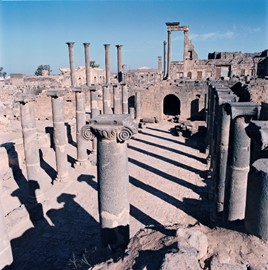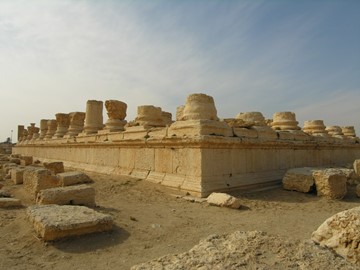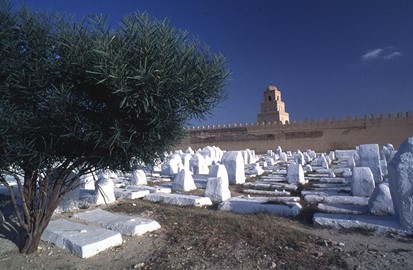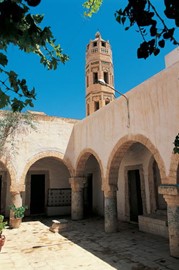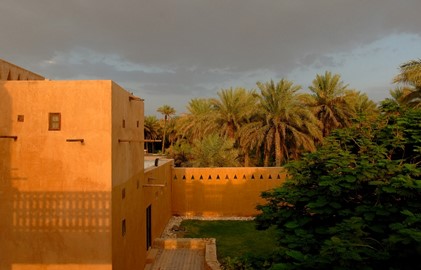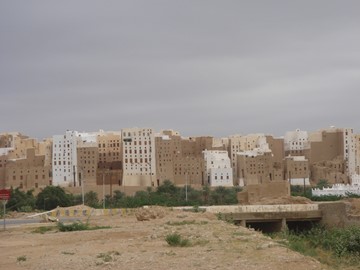region :: arab states
Damascus
The Ancient City of Damascus, a UNESCO World Heritage site in Syria, is one of the oldest continuously inhabited cities in the world, with a history dating back over 11,000 years. Renowned for its well-preserved medieval architecture, the city features significant landmarks like the Umayyad Mosque, a masterpiece of Islamic design, and bustling souks that reflect its rich cultural and commercial past. Its strategic location made it a vital hub for trade and civilization, blending influences from Roman, Byzan... Read More
Bosra
The Ancient City of Bosra, a UNESCO World Heritage site in Syria, is renowned for its well-preserved Roman, Byzantine, and Islamic architecture. This historic city features a remarkable 2nd-century Roman theater, one of the best-preserved in the world, alongside ancient mosques, churches, and a sprawling network of ruins. Bosra’s significance lies in its role as a key trading hub along ancient caravan routes, reflecting a rich blend of cultural influences over centuries. Today, it stands as a testament to S... Read More
Palmyra
Palmyra, a UNESCO World Heritage site in Syria, is an ancient city renowned for its well-preserved Roman-era ruins. Dating back to the 1st and 2nd centuries, it served as a vital trading hub along the Silk Road, blending Greco-Roman architecture with local influences. Notable landmarks include the grand colonnaded street, the Temple of Bel, and the iconic Tetrapylon, showcasing its historical and cultural significance. Despite suffering damage during recent conflicts, Palmyra remains a testament to the regi... Read More
Ichkeul
Ichkeul National Park, a UNESCO World Heritage site in Tunisia, is a vital wetland ecosystem renowned for its rich biodiversity. It serves as a critical wintering ground for hundreds of thousands of migratory birds, including rare species like the white-headed duck and ferruginous duck. The park’s unique combination of lake, marshes, and surrounding hills supports a diverse range of flora and fauna, making it an ecological treasure. Its significance as a natural haven has earned it international recognition... Read More
Carthage
Carthage, a UNESCO World Heritage site in Tunisia, is an ancient city founded by the Phoenicians in the 9th century BCE, renowned for its historical significance as a major Mediterranean power. It features impressive archaeological remains, including the Roman Antonine Baths, the Punic Ports, and the Byrsa Hill citadel, showcasing a blend of Phoenician, Roman, and Byzantine influences. Once a rival to Rome, Carthage played a pivotal role in the Punic Wars before its destruction and later reconstruction by t... Read More
Kerkuane
The Punic Town of Kerkuane and its Necropolis, a UNESCO World Heritage site in Tunisia, is a well-preserved archaeological gem from the 6th century BCE. Founded by the Phoenicians, it showcases ancient urban planning with residential quarters, temples, and a sophisticated drainage system, offering a rare glimpse into Punic civilization before its destruction by Rome. The adjacent necropolis features burial chambers and artifacts that highlight the cultural and religious practices of the time. This site stan... Read More
Dougga / Thugga
Dougga, also known as Thugga, is a UNESCO World Heritage site in Tunisia, renowned as the best-preserved Roman small town in North Africa. Originally a Numidian settlement, it flourished under Roman and Byzantine rule, showcasing a rich blend of Libyco-Punic, Roman, and indigenous influences through its well-maintained ruins, including a theater, capitol, and mausoleum. Designated a World Heritage site in 1997, it offers a unique glimpse into ancient daily life and cultural synthesis. Its remote location ha... Read More
Amphitheatre of El Jem
The Amphitheatre of El Jem, a UNESCO World Heritage site in Tunisia, is an impressive Roman-era monument renowned for its well-preserved structure and historical significance. Constructed in the 3rd century AD, this grand amphitheater once hosted gladiatorial contests and public spectacles, showcasing the architectural prowess of the Roman Empire. Its massive stone walls and tiered seating, capable of holding up to 35,000 spectators, stand as a testament to its past grandeur. Today, it remains a striking sy... Read More
Kairouan
Kairouan, a UNESCO World Heritage site in Tunisia, is a historic city renowned for its rich Islamic heritage. Founded in 670 AD, it served as a key center for religious scholarship and trade in North Africa. The Great Mosque of Kairouan, one of the oldest and most prestigious mosques in the Muslim world, stands as a testament to its architectural and cultural significance. Its well-preserved medina, with narrow streets and traditional markets, further highlights its historical importance.
Medina of Sousse
The Medina of Sousse, a UNESCO World Heritage site in Tunisia, is a well-preserved example of an early Islamic fortified city, established during the Aghlabid period (800–909) as a key commercial and military port. Its historic core features a robust kasbah, imposing ramparts, the Great Mosque, and the Ribat—a unique blend of fort and religious structure—reflecting Arabo-Muslim urbanism and coastal defense architecture. The medina’s narrow streets, traditional souks, and Archaeological Museum with its stunn... Read More
Medina of Tunis
The Medina of Tunis, a UNESCO World Heritage site in Tunisia, is a historic urban center founded in 698 AD around the Zitouna Mosque, flourishing under the Almohad and Hafsid dynasties from the 12th to 16th centuries as one of the Islamic world’s greatest cities. It features a well-preserved maze of narrow streets, souks, and over 700 monuments, including palaces, mosques, and mausoleums, reflecting a rich blend of Arab-Muslim architecture and cultural heritage. Recognized in 1979, it exemplifies traditiona... Read More
Al Ain
Al Ain, a UNESCO World Heritage site in the United Arab Emirates, is an ancient oasis city renowned for its rich history and cultural significance. Known as the 'Garden City,' it features well-preserved Bronze Age tombs, traditional falaj irrigation systems, and the historic Al Jahili Fort, reflecting its importance as a trade and agricultural hub along ancient caravan routes. The city’s archaeological sites, including Hili and Bidaa Bint Saud, offer insights into millennia of human settlement, making it a ... Read More
Shibam
The Old Walled City of Shibam, a UNESCO World Heritage site in Yemen, is renowned for its unique 16th-century architecture featuring tall mudbrick towers, earning it the nickname 'Manhattan of the Desert.' This ancient city showcases an exceptional example of urban planning, with its densely packed, multi-story buildings constructed from sun-dried mud bricks, designed to maximize space and provide defense. Its historical significance lies in its well-preserved state, reflecting traditional building techniqu... Read More
Sana'a
The Old City of Sana'a, a UNESCO World Heritage site, is renowned for its unique architecture featuring multi-story tower houses made of rammed earth and decorated with intricate geometric patterns. This historic city, inhabited for over 2,500 years, showcases a rich cultural legacy with its ancient mosques, bustling souks, and traditional hammams. Its preservation reflects Yemen's historical significance as a center of trade and Islamic scholarship.
Zabid
The Historic Town of Zabid, a UNESCO World Heritage Site in Yemen, is renowned for its exceptional domestic and military architecture, reflecting its significance as a political and cultural hub from the 13th to 15th centuries. Once a thriving center of Islamic learning, it boasts the highest concentration of mosques in Yemen, including the prominent Great Mosque, alongside vestiges of its historic university. Designated in 1993, Zabid was added to the List of World Heritage in Danger in 2000 due to deterio... Read More
Socotra Archipelago
The Socotra Archipelago, a UNESCO World Heritage site in Yemen, is renowned for its extraordinary biodiversity and unique ecosystem. Often called the 'Galápagos of the Indian Ocean,' it hosts a variety of endemic species, including the iconic dragon’s blood tree with its striking umbrella shape. Its isolation has preserved a rich natural heritage, making it a globally significant ecological treasure.
Arabian Oryx Sanctuary
The Arabian Oryx Sanctuary, a UNESCO World Heritage site in Oman, is a protected reserve renowned for its successful conservation of the Arabian oryx, a species once extinct in the wild. Established to safeguard this iconic antelope, the sanctuary showcases a unique desert ecosystem with diverse flora and fauna, including rare migratory birds and endemic plants. Its recognition by UNESCO highlights its global significance as a model for wildlife preservation and sustainable environmental management. Visitor... Read More

